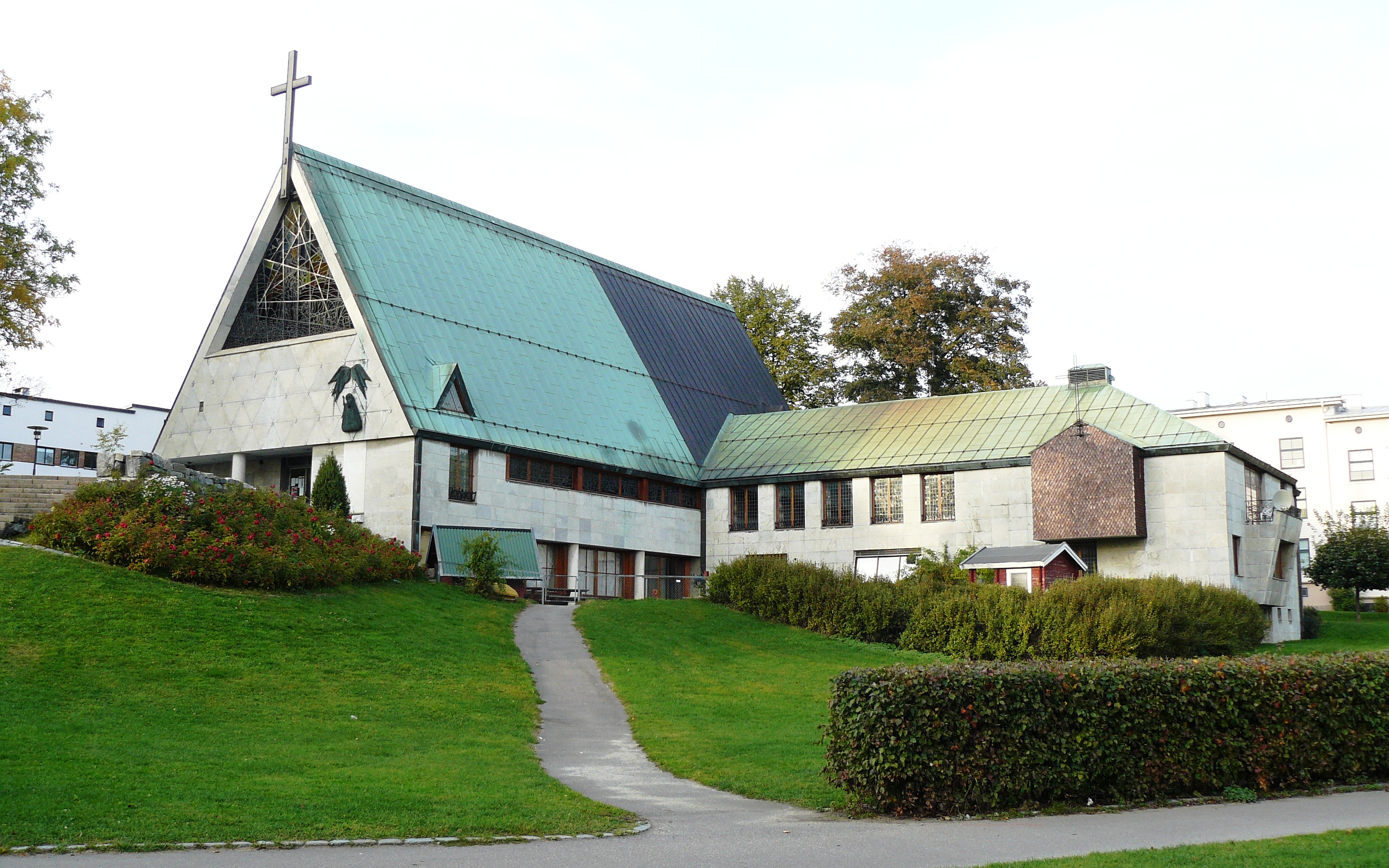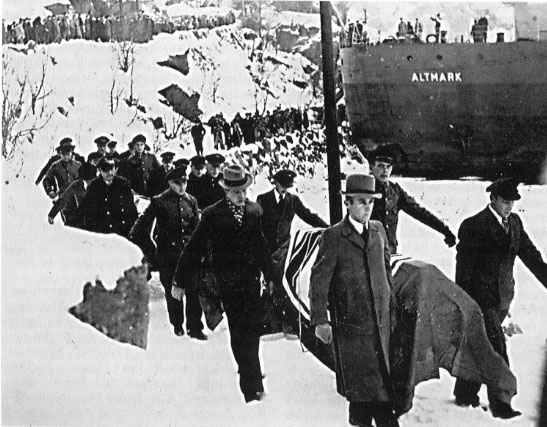|
Frithjof Tidemand-Johannessen
Carl Frithjof Tidemand-Johannessen (11 September 1916 – 9 October 1958) was a Norwegian designer, illustrator, writer, author, and craftsman. He is best known today for his woodcut prints and for the decorative works on the Torshov Church in Oslo. Background Tidemand-Johannessen received his artistic education at the Norwegian National Academy of Craft and Art Industry 1935–37 under Per Krohg, and made his debut at Høstutstillingen in Oslo in 1936. Tidemand-Johannessen then began studies at the Berlin University of the Arts, but was expelled by the Nazi management of the academy after three weeks for allegedly being a "Degenerate artist". After that, he participated in an illegal, underground academy in Berlin for about a year, and made study trips to Austria and Hungary. During World War II, Tidemand-Johannessen participated in the defense of Norway in 1940, and then in the Norwegian resistance to the German occupation. He was arrested in February 1941 by the ... [...More Info...] [...Related Items...] OR: [Wikipedia] [Google] [Baidu] |
Torshov Kirke - Glassmosaikk
Torshov is a neighborhood north of Grünerløkka and Lilleborg in the borough Sagene in Oslo, Norway. Oslo Tramway (''Trikken i Oslo'') provides connections with lines running between Majorstuen and Kjelsås. Vogts gate serves as the main street of the neighborhood. Along Vogts gate are several coffee shops, restaurants and cafes. The Torshov public school was built in 1878. Torshov was separated from Sagene as a separate congregation in 1930. The local sports club is Skeid Fotball. Torshov Church Torshov church (''Torshov kirke'') was consecrated in 1958. The church is located in Torshov kirkepark, between Åsengata and Nordkappgata. The building was built of stone and wood with copper plates, and has 400 seats. The church was designed by the architects Ulf Nyquist and Per Sunde, while the interior decorations were designed by Frithjof Tidemand-Johannessen. Etymology The area is named after an old farm, ''Torshov gård'' (Old Norse ''Þórshof''). The first element is the ... [...More Info...] [...Related Items...] OR: [Wikipedia] [Google] [Baidu] |
Torshov Kirke - Den Gode Hyrde
Torshov is a neighborhood north of Grünerløkka and Lilleborg in the borough Sagene in Oslo, Norway. Oslo Tramway (''Trikken i Oslo'') provides connections with lines running between Majorstuen and Kjelsås. Vogts gate serves as the main street of the neighborhood. Along Vogts gate are several coffee shops, restaurants and cafes. The Torshov public school was built in 1878. Torshov was separated from Sagene as a separate congregation in 1930. The local sports club is Skeid Fotball. Torshov Church Torshov church (''Torshov kirke'') was consecrated in 1958. The church is located in Torshov kirkepark, between Åsengata and Nordkappgata. The building was built of stone and wood with copper plates, and has 400 seats. The church was designed by the architects Ulf Nyquist and Per Sunde, while the interior decorations were designed by Frithjof Tidemand-Johannessen. Etymology The area is named after an old farm, ''Torshov gård'' (Old Norse ''Þórshof''). The first element is th ... [...More Info...] [...Related Items...] OR: [Wikipedia] [Google] [Baidu] |
Torshov
Torshov is a neighborhood north of Grünerløkka and Lilleborg in the borough Sagene in Oslo, Norway. Oslo Tramway (''Trikken i Oslo'') provides connections with lines running between Majorstuen and Kjelsås. Vogts gate serves as the main street of the neighborhood. Along Vogts gate are several coffee shops, restaurants and cafes. The Torshov public school was built in 1878. Torshov was separated from Sagene as a separate congregation in 1930. The local sports club is Skeid Fotball. Torshov Church Torshov church (''Torshov kirke'') was consecrated in 1958. The church is located in Torshov kirkepark, between Åsengata and Nordkappgata. The building was built of stone and wood with copper plates, and has 400 seats. The church was designed by the architects Ulf Nyquist and Per Sunde, while the interior decorations were designed by Frithjof Tidemand-Johannessen. Etymology The area is named after an old farm, ''Torshov gård'' (Old Norse ''Þórshof''). The first element is ... [...More Info...] [...Related Items...] OR: [Wikipedia] [Google] [Baidu] |
Carl Frithjof Tidemand-Johannessen 1957
Carl may refer to: *Carl, Georgia, city in USA *Carl, West Virginia, an unincorporated community *Carl (name), includes info about the name, variations of the name, and a list of people with the name *Carl², a TV series * "Carl", an episode of television series ''Aqua Teen Hunger Force'' * An informal nickname for a student or alum of Carleton College CARL may refer to: *Canadian Association of Research Libraries *Colorado Alliance of Research Libraries See also *Carle (other) *Charles *Carle, a surname *Karl (other) *Karle (other) Karle may refer to: Places * Karle (Svitavy District), a municipality and village in the Czech Republic * Karli, India, a town in Maharashtra, India ** Karla Caves, a complex of Buddhist cave shrines * Karle, Belgaum, a settlement in Belgaum d ... {{disambig ja:カール zh:卡尔 ... [...More Info...] [...Related Items...] OR: [Wikipedia] [Google] [Baidu] |
Åkebergveien
Åkebergveien is a street in Oslo, Norway. The street is named after the former farm Åkeberg. ''Åkebergveien 11'' formerly belonged to the brewery Ytteborgs Aktiebryggeri. In 1934 the building was acquired by the city of Oslo, and after rebuilding became part of the district prison of Oslo, currently department B of Oslo Prison ( no, Oslo fengsel). The prison is popularly called "Bayer'n", due to its history as a brewery. During the occupation of Norway by Nazi Germany, part of the prison was used by the Germans for political prisoners and detainees. The former Botsfengselet, currently department A of Oslo Prison, is located nearby. ''Åkebergveien 50'' was the first municipal apartment building An apartment (American English), or flat (British English, Indian English, South African English), is a self-contained housing unit (a type of residential real estate) that occupies part of a building, generally on a single story. There are ... of Oslo. References Streets ... [...More Info...] [...Related Items...] OR: [Wikipedia] [Google] [Baidu] |
Hungary
Hungary ( hu, Magyarország ) is a landlocked country in Central Europe. Spanning of the Carpathian Basin, it is bordered by Slovakia to the north, Ukraine to the northeast, Romania to the east and southeast, Serbia to the south, Croatia and Slovenia to the southwest, and Austria to the west. Hungary has a population of nearly 9 million, mostly ethnic Hungarians and a significant Romani minority. Hungarian, the official language, is the world's most widely spoken Uralic language and among the few non-Indo-European languages widely spoken in Europe. Budapest is the country's capital and largest city; other major urban areas include Debrecen, Szeged, Miskolc, Pécs, and Győr. The territory of present-day Hungary has for centuries been a crossroads for various peoples, including Celts, Romans, Germanic tribes, Huns, West Slavs and the Avars. The foundation of the Hungarian state was established in the late 9th century AD with the conquest of the Carpathian Basin by Hungar ... [...More Info...] [...Related Items...] OR: [Wikipedia] [Google] [Baidu] |
World War II
World War II or the Second World War, often abbreviated as WWII or WW2, was a world war that lasted from 1939 to 1945. It involved the vast majority of the world's countries—including all of the great powers—forming two opposing military alliances: the Allies and the Axis powers. World War II was a total war that directly involved more than 100 million personnel from more than 30 countries. The major participants in the war threw their entire economic, industrial, and scientific capabilities behind the war effort, blurring the distinction between civilian and military resources. Aircraft played a major role in the conflict, enabling the strategic bombing of population centres and deploying the only two nuclear weapons ever used in war. World War II was by far the deadliest conflict in human history; it resulted in 70 to 85 million fatalities, mostly among civilians. Tens of millions died due to genocides (including the Holocaust), starvation, ma ... [...More Info...] [...Related Items...] OR: [Wikipedia] [Google] [Baidu] |
Operation Weserübung
Operation Weserübung (german: Unternehmen Weserübung , , 9 April – 10 June 1940) was Germany's assault on Denmark and Norway during the Second World War and the opening operation of the Norwegian Campaign. In the early morning of 9 April 1940 (''Wesertag'', "Weser Day"), Germany occupied Denmark and invaded Norway, ostensibly as a preventive manoeuvre against a planned, and openly discussed, French-British occupation of Norway known as Plan R 4 (actually developed as a response to any German aggression against Norway). After the occupation of Denmark (the Danish military was ordered to stand down as Denmark did not declare war with Germany), envoys of the Germans informed the governments of Denmark and Norway that the ''Wehrmacht'' had come to protect the countries' neutrality against Franco-British aggression. Significant differences in geography, location and climate between the two nations made the actual military operations very dissimilar. The invasion fleet's no ... [...More Info...] [...Related Items...] OR: [Wikipedia] [Google] [Baidu] |
Norwegian Resistance
The Norwegian resistance (Norwegian: ''Motstandsbevegelsen'') to the occupation of Norway by Nazi Germany began after Operation Weserübung in 1940 and ended in 1945. It took several forms: *Asserting the legitimacy of the exiled government, and by implication the lack of legitimacy of Vidkun Quisling's pro-Nazi regime and Josef Terboven's military administration *The initial defence in Southern Norway, which was largely disorganised, but succeeded in allowing the government to escape capture *The more organised military defence and counter-attacks in parts of Western and Northern Norway, aimed at securing strategic positions and the evacuation of the government *Armed resistance, in the form of sabotage, commando raids, assassinations and other special operations during the occupation *Civil disobedience and unarmed resistance Asserting legitimacy of exiled Norwegian government The Norwegian government of Prime Minister Johan Nygaardsvold, with the exception of foreign mini ... [...More Info...] [...Related Items...] OR: [Wikipedia] [Google] [Baidu] |
Grini Concentration Camp
'', '' no, Grini fangeleir'', location=Bærum, Viken, Norway, location map=Viken#Norway, built by=Norway, original use=Constructed as a women's prison, operated by=Nazi Germany, notable inmates= List of Grini prisoners, liberated by=Harry Söderman, construction=1938–1940, image size=300px Grini prison camp ( no, Grini fangeleir, german: Polizeihäftlingslager Grini) was a Nazi concentration camp in Bærum, Norway, which operated between 1941 and May 1945. Ila Detention and Security Prison is now located here. History Grini was originally built as a women's prison, near an old croft named ''Ilen'' (also written ''Ihlen''), on land bought from the Løvenskiold family by the Norwegian state. The construction of a women's prison started in 1938, but despite being more or less finished in 1940, it did not come into use for its original purpose: Nazi Germany's invasion of Norway on 9 April 1940, during World War II, instead precipitated the use of the site for detention by the Nazi ... [...More Info...] [...Related Items...] OR: [Wikipedia] [Google] [Baidu] |
Degenerate Art
Degenerate art (german: Entartete Kunst was a term adopted in the 1920s by the Nazi Party in Germany to describe modern art. During the dictatorship of Adolf Hitler, German modernist art, including many works of internationally renowned artists, was removed from state-owned museums and banned in Nazi Germany on the grounds that such art was an "insult to German feeling", un-German, Freemasonic, Jewish, or Communist in nature. Those identified as degenerate artists were subjected to sanctions that included being dismissed from teaching positions, being forbidden to exhibit or to sell their art, and in some cases being forbidden to produce art. ''Degenerate Art'' also was the title of an exhibition, held by the Nazis in Munich in 1937, consisting of 650 modernist artworks chaotically hung and accompanied by text labels deriding the art. Designed to inflame public opinion against modernism, the exhibition subsequently traveled to several other cities in Germany and Austria. While m ... [...More Info...] [...Related Items...] OR: [Wikipedia] [Google] [Baidu] |








